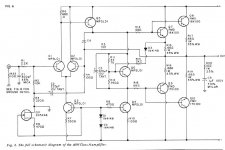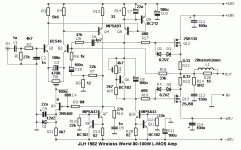There are many free application notes available on stability just google
D. Feucht, 2-pole compensation
R. Mancini, SLOA020A from TI
and more. These cover the technical side of things, for listening impressions you need to dig the forum.
Have fun, Hannes
D. Feucht, 2-pole compensation
R. Mancini, SLOA020A from TI
and more. These cover the technical side of things, for listening impressions you need to dig the forum.
Have fun, Hannes
Hi,
in a later version of the JLH he adopted a variable resistor for R5 and said trim until the squarewave was the most accurate shape. But he had 5 different locations where he installed comp in this one amplifier. Crimson also has multiple comp locations.
This type of compensation is very common in British designed amplifiers. Much less common outside the UK.
Notice the ratio of nearly 3:1 for r20:r14, the delay on the q9 protection and 4locations for comp.
What is the purpose of C4?
in a later version of the JLH he adopted a variable resistor for R5 and said trim until the squarewave was the most accurate shape. But he had 5 different locations where he installed comp in this one amplifier. Crimson also has multiple comp locations.
This type of compensation is very common in British designed amplifiers. Much less common outside the UK.
Notice the ratio of nearly 3:1 for r20:r14, the delay on the q9 protection and 4locations for comp.
What is the purpose of C4?
Last edited:
Hello
Here is the link to the two articles of D. Feucht about 2-pole compensation:
Part 1:
http://www.analogzone.com/col_0628.pdf
Part 2:
http://www.analogzone.com/col_0719.pdf
Bye
Gaetan
Here is the link to the two articles of D. Feucht about 2-pole compensation:
Part 1:
http://www.analogzone.com/col_0628.pdf
Part 2:
http://www.analogzone.com/col_0719.pdf
Bye
Gaetan
Last edited:
- Status
- Not open for further replies.

